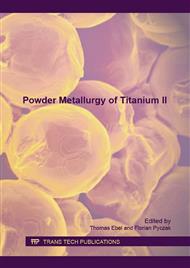[1]
P. Sun, Z. Z. Fang, M. Koopman, J. Paramore, and K. S. R. Chandran, An experimental study of the ( Ti – 6Al – 4V )– xH phase diagram using in situ synchrotron XRD and TGA / DSC techniques, Acta Mater., vol. 84, p.29–41, (2015).
DOI: 10.1016/j.actamat.2014.10.045
Google Scholar
[2]
P. Sun, Z. Z. Fang, and M. Koopman, A Comparison of Hydrogen Sintering and Phase Transformation (HSPT) Processing with Vacuum Sintering of CP-Ti, Adv. Eng. Mater., no. 10, p. n/a–n/a, Jun. (2013).
DOI: 10.1002/adem.201300017
Google Scholar
[3]
Z. Z. Fang, P. Sun, and H. Wang, Hydrogen Sintering of Titanium to Produce High Density Fine Grain Titanium Alloys, Adv. Eng. Mater., vol. 14, no. 6, p.383–387, Jun. (2012).
DOI: 10.1002/adem.201100269
Google Scholar
[4]
P. Sun, Z. Z. Fang, M. Koopman, Y. Xia, J. Paramore, K. S. Ravi Chandran, Y. Ren, and J. Lu, Phase Transformations and Formation of Ultra-Fine Microstructure During Hydrogen Sintering and Phase Transformation (HSPT) Processing of Ti-6Al-4V, Metall. Mater. Trans. A, Sep. (2015).
DOI: 10.1007/s11661-015-3141-8
Google Scholar
[5]
J. D. Paramore, Z. Z. Fang, P. Sun, M. Koopman, K. S. R. Chandran, and M. Dunstan, A powder metallurgy method for manufacturing Ti-6Al-4V with wrought-like microstructures and mechanical properties via hydrogen sintering and phase transformation ( HSPT ), Scr. Mater., vol. 107, p.103–106, (2015).
DOI: 10.1016/j.scriptamat.2015.05.032
Google Scholar
[6]
F. Cao, K. S. R. Chandran, P. Kumar, P. Sun, M. Koopman, and Z. Z. Fang, Improved fatigue performance of PM Ti-6Al-4V alloy processed by hydrogen sintering and phase transformation of TiH2 powders, in TMS Ti 2015, (2015).
DOI: 10.1002/9781119296126.ch247
Google Scholar
[7]
M. Qian and F. H. Froes, Eds., Titanium Powder Metallurgy: Science, Technology and Applications. Elsevier Science, (2015).
Google Scholar
[8]
A. D. Hartman, S. J. Gerdemann, and J. S. Hansen, Producing lower-cost titanium for automotive applications, Jom, vol. 50, no. 9, p.16–19, (1998).
DOI: 10.1007/s11837-998-0408-1
Google Scholar
[9]
D. Eylon, F. H. (Sam) Froes, and S. Abkowitz, Powder Metallurgy Technolgies and Applications, in ASM Handbook, Vol. 7, ASM, 1998, p.874–886.
Google Scholar
[10]
Z. Zak Fang and P. Sun, Pathways to Optimize Performance/Cost Ratio of Powder Metallurgy Titanium – A Perspective, Key Eng. Mater., vol. 520, p.15–23, Aug. (2012).
DOI: 10.4028/www.scientific.net/kem.520.15
Google Scholar
[11]
J. Greenspan, F. J. Rizzitano, and E. Scala, Titanium Powder Metallurgy By Decomposition Sintering of the Hydride, Titanium, Sci. Technol. Proc. Second Int. Conf., vol. 1, p.365–379, (1973).
DOI: 10.1007/978-1-4757-1346-6_28
Google Scholar
[12]
O. M. Ivasishin, D. G. Savvakin, F. Froes, V. C. Mokson, and K. a. Bondareva, SYNTHESIS OF ALLOY Ti-6Al-4V WITH LOW RESIDUAL POROSITY BY A POWDER METALLURGY METHOD, Powder Metall. Met. Ceram., vol. 41, no. 7–8, p.382–390, (2002).
DOI: 10.1023/a:1021117126537
Google Scholar
[13]
O. M. Ivasishin, D. G. Savvakin, V. S. Moxson, K. a. Bondareva, and F. H. S. A. M. Froes, Titanium Powder Metallurgy for Automotive Components., Material Technology, (2002).
DOI: 10.1002/9781118788028.ch14
Google Scholar
[14]
ASTM Standard B348-10 Standard Specification for Titanium and Titanium Alloy Bars and Billets, West Conshohocken: ASTM International, (2010).
Google Scholar
[15]
M. J. Donachie, Titanium: A Technical Guide, 2nd Edition. ASM International, (2000).
Google Scholar
[16]
R. M. Barrer, Diffusion in and Through Solids. London: Bentley House: Cambridge University Press, (1941).
Google Scholar
[17]
J. Crank, The Mathematics of Diffusion, 2nd ed. Oxford: Clarendon Press, (1975).
Google Scholar
[18]
R. J. Wasilewski and G. L. Kehl, Diffusion of Hydrogen in Titanium, Metallurgia, vol. 50, no. November, p.225–230, (1954).
Google Scholar
[19]
T. P. Papazoglou and M. T. Hepworth, The Diffusion of Hydrogen in Titanium, Trans. Metall. Soc. AIME, vol. 242, no. April, p.682–685, (1968).
Google Scholar


